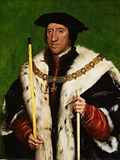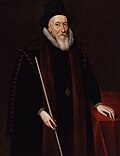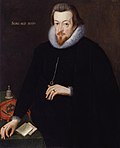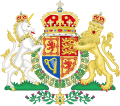List of English chief ministers
This article includes a list of general references, but it lacks sufficient corresponding inline citations. (July 2017) |
Chief minister is a term used retroactively by historians to describe servants of the English monarch who presided over the government of England, and after 1707, Great Britain, before 1721. Chief ministers were usually one of the great officers of state, but it was not unusual for there to be no chief minister.[1]
Under the Norman and Angevin kings, the justiciar was often chief minister. When kings left England to oversee other parts of the Angevin Empire, the justiciar functioned as his viceroy or regent. In the 13th century, after the loss of the Angevin territories in France, the justiciar's power declined as monarchs resided permanently in England.[2]
For the next three centuries, the Lord Chancellor was most often chief minister. The chancellor served as Keeper of the Great Seal, presided over the Privy Council and Parliament, and led the High Court of Chancery. After the English Reformation, the chancellor's power shifted to the Lord High Treasurer.[3] After 1721, the office of prime minister became the head of British governments.
This list of chief ministers is organised by royal dynasty. For a list of particular governments of the Kingdom of England, see List of English ministries.
Anglo-Saxons
[edit]| Minister | Birth | Death | Formal office(s) | Monarch | |
|---|---|---|---|---|---|
| Dunstan, Archbishop of Canterbury 946–955[4] | c. 920, near Glastonbury Son of Thegn Heorstan and Cynethryth | 19 May 988 | Treasurer Chancellor | Eadred (946–955) | |
| No informal holder; personal rule of King Eadwig (955–959) | |||||
| Dunstan, Archbishop of Canterbury 959–978[5] | c. 920, near Glastonbury Son of Thegn Heorstan and Cynethryth | 19 May 988 | Chancellor | Edgar (959–975) | |
| No informal holder (978–1021) | |||||
| Godwin, Earl of Wessex 1022–1053[6] | c. 988, England Son of Wulfnoth Cild | 15 April 1053 | Justiciar Treasurer | Cnut (1016–1035) Harold I (1035–1040) Harthacnut (1040–1042) Edward the Confessor (1042–1066) | |
| Harold, Earl of Wessex 1053–1066[7] | c. 1022, England Son of Godwin, Earl of Wessex | 14 October 1066 | — | ||
Normans
[edit]| Minister | Birth | Death | Formal office(s) | Monarch | |
|---|---|---|---|---|---|
| No informal holder; personal rule of King William I (1066–1087) | |||||
| Ranulf Flambard, Bishop of Durham 1089–1100[8] | c. 1060, near Bayeux Son of Thurstin | 5 September 1128, Durham | Treasurer Justiciar Keeper of the Great Seal | William II (1087–1100) | |
| Roger, Bishop of Salisbury 1100–1135[9] | c. 1070-1080, Normandy | 11 December 1139, Salisbury | Lord Chancellor Justiciar | Henry I (1100–1135) | |
Plantagenets
[edit]| Minister | Birth | Death | Formal office(s) | Monarch |
|---|---|---|---|---|
| Thomas Becket, Archbishop of Canterbury 1155–1162[4] | 21 December 1118, London Son of Gilbert and Matilda Beket | 29 December 1170, Canterbury | Lord Chancellor | Henry II (1154–1189) |
| No informal holder; personal rule of king Henry II (1162–1189) | ||||
| William de Longchamp, Bishop of Ely 1190–1191[10][11] | Normandy Son of Hugh de Longchamp and Eve de Lacy | January 1197 | Justiciar Lord Chancellor | Richard I (1189–1199) |
| Walter de Coutances, Archbishop of Rouen 1191–1194[12] | Cornwall Son of Reinfrid and Gonilla | 16 November 1207 | Justiciar | |
| No informal holder; personal rule of King Richard I (1194–1199) | ||||
| William Marshal, 1st Earl of Pembroke 1213–1216[13] | c. 1145, Wiltshire Son of John Marshall and Sybilla of Salisbury | 14 May 1219, Caversham | Lord Marshal | John (1199–1216) |
| William Marshal, 1st Earl of Pembroke 1216–1219[14] | c. 1145 Wiltshire Son of John Marshall and Sybilla of Salisbury | 14 May 1219, Caversham | Regent Lord Marshal | Henry III (1216–1272) |
| Hubert de Burgh, Earl of Kent 1219–1232[15][16] | c. 1175, Norfolk Son of Sir Reyner de Burgh | c. 5 May 1243, Banstead | Regent (1219–1227) Justiciar | |
| Peter des Roches, Bishop of Winchester 1232–1234[17] | — | 9 June 1238 | — | |
| Personal rule (1234–1258); Council of Fifteen (1258–1261); Personal rule (1262–1264) | ||||
| Simon de Montfort, 6th Earl of Leicester 1264–1265[18] | c. 1208, Montfort-l'Amaury Son of Simon de Montfort, 5th Earl of Leicester and Alix de Montmorency | 4 August 1265, Evesham | Lord High Steward Protector of the Realm | |
| No informal holder; personal rule of King Henry III (1265–1272) | ||||
| Regents: Walter Giffard, Roger Mortimer, and Robert Burnell (1272–1274)[19] | Edward I (1272–1307) | |||
| Robert Burnell, Bishop of Bath and Wells 1274–1292[20] | c. 1235, Acton Burnell Son of Robert Burnell | 25 October 1292, | Lord Chancellor | |
- 1330–1340: John de Stratford, Archbishop of Canterbury
- 1367–1371: William of Wykeham, Bishop of Winchester
- 1389–1391: William of Wykeham, Bishop of Winchester
House of Lancaster
[edit]- 1413–1417: Henry Beaufort, Cardinal, Bishop of Winchester
- 1422–1435: John, Duke of Bedford, Regent, died 14 September 1435
- 1422–1437: Humphrey, Duke of Gloucester, Regent, died 23 February 1447
- 1424–1427: Henry Beaufort, Cardinal, Bishop of Winchester
- 1432–1447: Henry Beaufort, Cardinal, Bishop of Winchester
- 1447–1450: William de la Pole, 1st Duke of Suffolk
- 3 April 1454 – February 1455: Richard Plantagenet, 3rd Duke of York
- 19 November 1455 – 25 February 1456: Richard Plantagenet, 3rd Duke of York, Protector (Regent) for King Henry VI
- 1470–1471: Richard Neville, 16th Earl of Warwick †; known as Warwick the Kingmaker; killed at the Battle of Barnet
House of York
[edit]- 1461–1467: Richard Neville, 16th Earl of Warwick; known as Warwick the Kingmaker
- 1475–1483: Thomas Rotherham, Archbishop of York
- 30 April – 26 June 1483: Richard Plantagenet, Duke of Gloucester, was Lord Protector of the Realm during the nominal reign of 12-year-old King Edward V (one of the "Princes in the Tower"), before claiming the throne for himself as King Richard III
House of Tudor
[edit]House of Stuart
[edit]Stuart Restoration
[edit]This is very true: for my words are my own, and my actions are my ministers.
In 1660, the leadership of the Commonwealth recalled Charles II and the chief minister became responsible to some extent to Parliament as leader of a ministry, although much of the time King Charles was in effect his own chief minister. The Glorious Revolution of 1688–89 furthered this process and by the time of Queen Anne in 1702, monarchs had little choice as to who their ministers would be.
Charles II and James II
[edit]| Portrait | Minister(s) (Birth–Death) | Term of office | Ministerial offices | Party | Election | Ministry | ||
|---|---|---|---|---|---|---|---|---|
 | 1st Earl of Clarendon (1609–1674) | 1660 | 1667 | First Lord of the Treasury (1660) Chancellor of the Exchequer (1660–61) Lord Chancellor | — | 1661 | Clarendon | |
 Buckingham | The C.A.B.A.L.
| 1667 | 1674 | — | Cabal | |||
 | 1st Earl of Danby (1632–1712) | 1674 | March 1679 | Lord High Treasurer | Tory | — | Danby I | |
 Temple | The Privy Council chaired by Sir William Temple (1628–1699) | April 1679 | November 1679 | — | Privy Council | |||
 Rochester  Godolphin  Sunderland | 1st Earl of Rochester (1642–1711) & 1st Earl of Godolphin (1645–1712) & 2nd Earl of Sunderland (1641–1702) | November 1679 | 1687 | (Rochester:) First Lord of the Treasury (1679–84) (Godolphin:) First Lord of the Treasury (1684–85) (Sunderland:) Northern Secretary (1679–80 & 1683–84) (Godolphin:) Northern Secretary (1684) (Sunderland:) Southern Secretary (1680–81 & 1684–88) (Rochester:) Lord High Treasurer (1685–87) | Tory | 1681 | The Chits | |
| 1685 | ||||||||
William III and Mary II
[edit]| Portrait | Minister(s) (Birth–Death) | Term of office | Ministerial offices | Party | Election | Ministry | ||
|---|---|---|---|---|---|---|---|---|
 Carmarthen  Halifax | 1st Marquess of Carmarthen (1632–1712) & 1st Marquess of Halifax (1633–1695) | 1689 | 8 February 1690 | (Carmarthen:) Lord President of the Council (Halifax:) Lord Privy Seal | — | 1689 | Carmarthen–Halifax | |
 | 1st Marquess of Carmarthen (1632–1712) | February 1690 | 1695 | Lord President of the Council | Tory | 1690 | Carmarthen | |
From 1693 and during the sole reign of William III, the government was increasingly dominated by the Whig Junto.
Anne
[edit]The Kingdoms of England and Scotland united to form the Kingdom of Great Britain in 1707.
| Portrait | Minister(s) (Birth–Death) | Term of office | Ministerial offices | Party | Election | Ministry | ||
|---|---|---|---|---|---|---|---|---|
 Godolphin  Marlborough | 1st Earl of Godolphin (1645–1712) & 1st Duke of Marlborough (1650–1722) | 1702 | 1710 | (Godolphin:) Lord High Treasurer (Marlborough:) Master-General of the Ordnance | Tory | 1702 | Godolphin–Marlborough | |
| 1705 | ||||||||
| 1708 | ||||||||
 | Robert Harley (1661–1724) | 1710 | 30 July 1714 | Chancellor of the Exchequer (1710–11) Lord High Treasurer (1711–14) | Tory (formerly Whig) | 1710 | Harley | |
| 1713 | ||||||||
 | 1st Duke of Shrewsbury (1660–1718) | 30 July 1714 | 13 October 1714 | Lord High Treasurer | Tory | — | ||
Hanoverian Succession
[edit]In the immediate aftermath of the death of Queen Anne in 1714, the monarchy was unable to function as the new King was in his domains in Hanover and did not know of his accession. As a stopgap, Parliament elected Thomas Parker, 1st Earl of Macclesfield Regent, or "acting king" until the new monarch arrived to take his crown. Later, George, Prince of Wales reigned as regent for six months from July 1716 to January 1717 when the King went to Hanover.
In the early part of the reign of George I, who could not speak English, the cabinet began meeting without the monarch present.
Following the succession of George I and the resignation of the Duke of Shrewsbury in 1714, the office of Lord High Treasurer went into permanent commission, its function undertaken by a commission of Lords of the Treasury, chaired by the First Lord of the Treasury, rather than by an individual Lord High Treasurer. From 1714 to 1717 the ministry was led by Viscount Townshend, who was nominally Northern Secretary; the Earl of Halifax, the Earl of Carlisle and Sir Robert Walpole successively served alongside Townshend as nominal First Lord of the Treasury. From 1717 to 1721 Lords Stanhope (First Lord 1717–18) and Sunderland (First Lord 1718–21) led the administration jointly, with Stanhope managing foreign affairs and Sunderland managing home affairs. Stanhope died in February 1721 and Sunderland resigned in April 1721; Townshend and Walpole returned to office.
Thus the First Lord of the Treasury came to be the most powerful minister and the prototype of Prime Minister of the United Kingdom and its dominions.
George I
[edit]| Portrait | Minister(s) (Birth–Death) | Term of office | Ministerial offices | Party | Election | Ministry | ||
|---|---|---|---|---|---|---|---|---|
 | 2nd Viscount Townshend (1674–1738) | 13 October 1714 | 1716 | Northern Secretary | Whig | 1715 | Townshend | |
 Stanhope  Sunderland | 1st Viscount Stanhope (c. 1673–1721) & 3rd Earl of Sunderland (1675–1722) | 12 April 1717 | 21 March 1718 | (Stanhope:) First Lord of the Treasury Chancellor of the Exchequer (Sunderland:) Northern Secretary | Whig | — | Stanhope–Sunderland I | |
| 21 March 1718 | 4 April 1721 | (Sunderland:) First Lord of the Treasury (Stanhope:) Northern Secretary | Whig | Stanhope–Sunderland II | ||||
See also
[edit]Notes
[edit]- ^ Bigham 1925, p. 4.
- ^ Bigham 1925, pp. 1–2.
- ^ Bigham 1925, pp. 3–4.
- ^ a b Bigham 1925, p. 12.
- ^ Bigham 1925, p. 14.
- ^ Bigham 1925, pp. 20–25.
- ^ Bigham 1925, p. 28.
- ^ Bigham 1925, pp. 40–41.
- ^ Bigham 1925, pp. 47–52.
- ^ Maddicott 2010, p. 110.
- ^ Butt 1989, p. 45–46.
- ^ Maddicott 2010, pp. 110–111.
- ^ Bigham 1925, p. 76.
- ^ Bigham 1925, p. 77.
- ^ Bigham 1925, pp. 83 & 86.
- ^ Maddicott 2010, p. 167.
- ^ Maddicott 2010, pp. 167–168.
- ^ Bigham 1925, p. 104.
- ^ Powell & Wallis 1968, p. 201.
- ^ Bigham 1925, pp. 113–114.
References
[edit]- Bigham, Clive (1925). The Chief Ministers of England, 920–1720. London: John Murray.
- Butt, Ronald (1989). A History of Parliament: The Middle Ages. London: Constable. ISBN 0-0945-6220-2.
- Collier's Encyclopedia, vol. 9, Electron Gun to Fischer, pp. 184–185
- Collier's Encyclopedia, vol. 11, Germanium to Heath Hen, pp. 372–373
- Knowles, Elizabeth M. (1999), The Oxford Dictionary of Quotations, Oxford University Press, ISBN 978-0-19-860173-9
- Maddicott, J. R. (2010). The Origins of the English Parliament, 924-1327. Oxford University Press. ISBN 978-0-199-58550-2.
- Powell, J. Enoch; Wallis, Keith (1968). The House of Lords in the Middle Ages: A History of the English House of Lords to 1540. London: Weidenfeld & Nicolson. ISBN 0297761056.


 French
French Deutsch
Deutsch






















